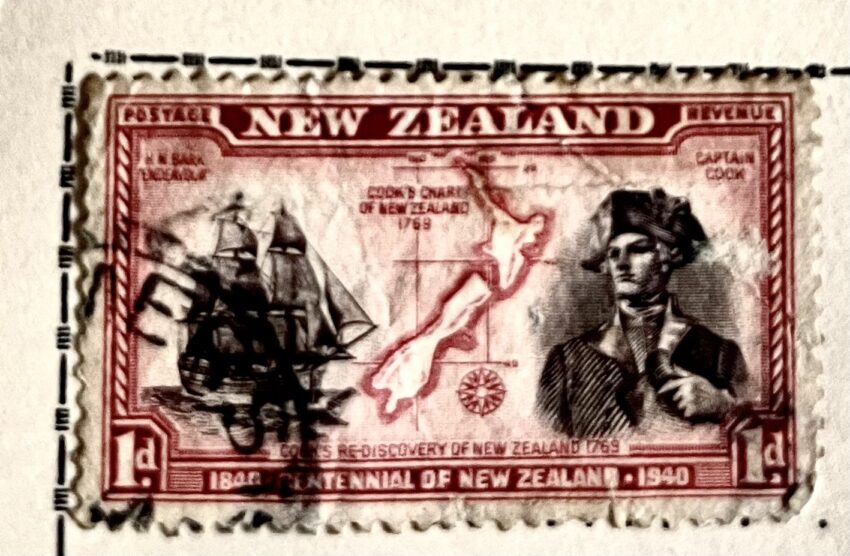In 1940 New Zealand celebrated the 100th anniversary of the signing of the Treaty of Waitangi. The one-penny stamp of the special centennial issue depicted Lieutenant James Cook, his ship Endeavour, and his map of New Zealand.
About New Zealand
New Zealand, a breathtaking jewel in the South Pacific, captivates with its stunning landscapes and vibrant culture. This island nation boasts snow-capped mountains, lush forests, and pristine beaches, inviting outdoor enthusiasts to explore its natural wonders. Its Maori heritage adds richness to the tapestry of traditions and customs, celebrated through mesmerizing haka performances and arts. New Zealanders are renowned for their friendly demeanor, embodying the “kiwi” spirit of warmth and inclusivity. Despite its modest size, the country embraces diversity and innovation, fostering a progressive society. From the majestic fjords to the buzzing urban hubs, New Zealand is a treasure trove of experiences waiting to be discovered.
New Zealand is a country with a fascinating history, unique geography, and many interesting facts. Here are some intriguing tidbits about New Zealand:
Biodiversity Hotspot: New Zealand is an ecological treasure, home to many unique plants and animals found nowhere else on Earth, such as the kiwi bird, tuatara (a living fossil reptile), and the world’s smallest dolphin, the Hector’s dolphin.
No Snakes: Unlike most countries, New Zealand has no native snake species. Its isolation from other landmasses allowed it to remain snake-free.
First Country to Grant Women the Right to Vote: In 1893, New Zealand became the first self-governing country to grant women the right to vote in parliamentary elections.
Earth’s Newest Landmass: New Zealand is part of the Zealandia continent, which is mostly submerged. It is the world’s newest and smallest continent.
About treaty of Waitangi
The Treaty of Waitangi is a crucial historical document in New Zealand that was signed on February 6, 1840, between representatives of the British Crown and various Māori chiefs. It is considered the founding document of modern New Zealand and played a significant role in shaping the relationship between the indigenous Māori people and the British settlers.
The main objectives of the Treaty were to establish a British presence in New Zealand and to secure British sovereignty over the islands. The Māori chiefs, on the other hand, sought to protect their rights, land, and culture.
The Treaty of Waitangi consists of three articles:
The Protection of Māori Rights: The first article guaranteed Māori chiefs and their tribes full ownership and possession of their lands, forests, fisheries, and other possessions. It granted the Māori people the same rights as British subjects.
Cession of Sovereignty: The second article stated that the Māori chiefs ceded their rights and sovereignty to the British Crown. In return, they were promised the protection and rights of British subjects.
Governorship: The third article established the role of the British Crown in New Zealand, appointing a British Governor to oversee the administration of the country.
Independence of New Zealand
New Zealand’s path to independence was a gradual and evolving process, different from the dramatic declarations of independence seen in other countries. The country’s journey towards self-governance can be traced through key milestones:
Early Colonization: New Zealand was discovered and settled by Polynesians around 1280 AD, well before European arrival. Captain James Cook, a British explorer, arrived in 1769, and over the following decades, European settlers, traders, and missionaries began to establish a presence in New Zealand.
Treaty of Waitangi (1840): As mentioned earlier, the Treaty of Waitangi was signed between the British Crown and Māori chiefs in 1840. While the treaty established British sovereignty, it also recognized the rights of Māori to their lands and resources.
British Colony (1840-1907): New Zealand was initially a British colony, administered by a Governor appointed by the British Crown. The country experienced conflicts between Māori and European settlers, particularly during the New Zealand Wars (1845-1872), which had a significant impact on Māori communities.
Self-Government (1852): In 1852, New Zealand became a self-governing colony with its own constitution. It established a Parliament with elected representatives, allowing for some degree of local decision-making.
Dominion Status (1907): In 1907, New Zealand achieved “dominion” status within the British Empire. This change recognized New Zealand as a self-governing and autonomous nation, although it was still formally connected to the British Crown.
Statute of Westminster (1931): The Statute of Westminster granted full legislative independence to the dominions, including New Zealand. It meant that the British Parliament could no longer legislate for New Zealand without the consent of its own Parliament.
New Zealand Citizenship Act (1948): New Zealand created its own distinct citizenship, separate from British subjects, further solidifying its status as an independent nation.
Becoming a Fully Independent Realm (1986): The Constitution Act of 1986 ended the last remaining constitutional ties with the United Kingdom. New Zealand became fully independent with its own legal framework, including the ability to amend its constitution without British involvement.
Today, New Zealand is a sovereign and independent nation, a member of the United Nations and the Commonwealth of Nations. While the British monarch is still recognized as the ceremonial head of state, the Governor-General represents the monarch in New Zealand, and the country’s government operates independently of the United Kingdom.
About the stamp
This stamp released in 1940 marked 100 years of the signing of treaty of Waitangi.
